The History of the Bed
From a Pile of Straw to King-Size Bliss
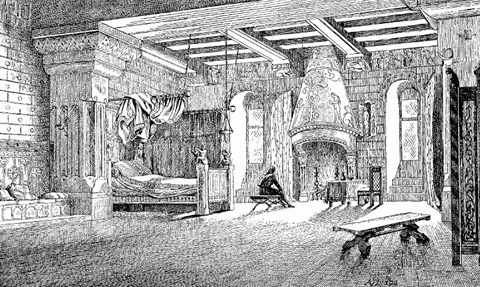
Since the dawn of time, man has sought, among other important things, a decent place to sleep. Over many thousands of years, as we became more and more civilized, so too did our beds. We’ve gone from sleeping on the hard ground or a pile of straw to the high-tech world of memory foam mattresses and Sleep Number® Beds. Along the way, our beds have come to mean a lot more to us than just a place to sleep. They’ve become a private refuge, a status symbol, a centerpiece of domestic life, a display of fine craftsmanship and even a work of art. Here, now, is the remarkable story of how the bed became what we know today. . .
Prehistoric Beds
Despite the impression you might have been given from Flintstones cartoons, life in prehistoric times wasn’t all brontosaurus burgers and octopus dishwashers. Our nomadic hunter-gatherer ancestors lived on the edge of survival and were constantly on the move. When it came time to sleep, all they could do was find a place where they would be reasonably protected from the elements, safe from predators and enemies. This often meant a cave. They would have made beds out of small indentations dug into the ground, or a pile of leaves or grass and maybe a stone pillow. The more successful hunters would have used furs to cover themselves and cushion the ground.
Beds in the Early Agrarian Age
About 10,000 years ago, (approximately 8000 BCE), man stopped wandering and settled down into permanent camps to farm. These early agrarians brought the very first civilizations into existence. They built simple shelters, tilled the soil, and hunted for animals within a relatively close radius to their homes.
Beds during this time were not all that different from nomadic beds. A corner of the dwelling was piled with leaves, grass, or straw, which may or may not have been covered with animal skins or furs. This provided a degree of cushioning from the hard ground, but it was still a fairly dirty business, full of insects and disease. Adding to the discomfort, entire families slept in the same space together.
Sleeping on the Ground
Over time, civilization progressed and the meager pile of straw evolved into the more refined pallet or ticking sack — usually woven out of cotton and stuffed with any soft material available. Depending on what was at hand, the filler would have ranged from grass, straw, leaves, grain or shucks, to wool, cotton, animal hair, feathers, or down. You could consider this to be the precursor of the modern mattress.
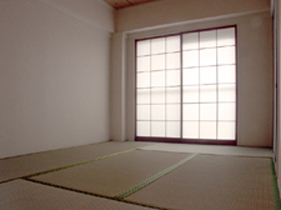
Some cultures — mostly in Asia and the western hemisphere — slept on mats woven out of various plant fibers. In Japan, a special mat called the tatami (meaning to fold or pile) was used as a seating and sleeping surface, and eventually came to cover the entire floor. Native Americans and other indigenous tribes used similar woven mats to protect them from the uncomfortable and dirty ground while sleeping and sitting.
As early as 3600 BCE, nomadic peoples in Persia filled goatskin bags with water, which they cleverly left outside in the daytime to absorb the heat from the sun; when night came, they provided not only cushioning but warmth as well.
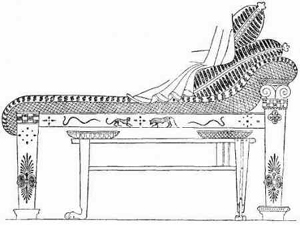
Off the Floor
The first record of a raised bed dates from around 3100 BCE in Egypt. Simple wooden platforms were built to lift the bed several inches to avoid dirt and drafts, as well as pests like insects, snakes, mice, and rats. Raising the bed also served to symbolize the occupant’s social status — the more important you were, the higher your bed. The super-elite would have had theirs decorated with gold, ebony, and jewels just to drive the point home. If you were a peasant, however, you were still down on the ground sleeping on palm fronds.
In the west, raised beds (or bedsteads) became much more common in the Middle Ages (5th through 15th centuries CE). They were basic wooden structures with leather or rope lattices built into the frames to support a pallet for cushioning. These strips of leather or rope stretched and sagged over time and had to be tightened periodically — giving birth to the old expression “sleep tight.”
Most families were large and lived in very small dwellings, so space was at a premium. Very often, beds were used not only for sleeping, but also as a place to sit, as a table, or to store items during the day (there’s just never enough closet space!). To have a bed sit empty and idle during the day in such a small area would have been unthinkably impractical for the average family.
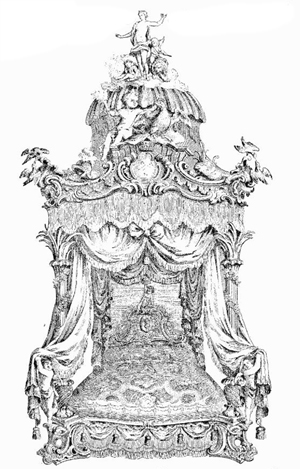
Beds as Luxury
By the late Middle Ages and early Renaissance (about the 14th century CE), the bed was becoming something else: a status symbol. For the chosen few, ornately carved bedsteads — often gilt, bejeweled, and painted with detailed images — were topped with thick feather or down mattresses and dressed with fine linen sheets. The entire bed was covered with fine woolen blankets and silk coverlets, and surrounded by sumptuous curtains of velvet and brocade. These beds were not only raised, but were often so high that a step or small ladder was needed just to get into them. This silly arms race of lavish material display culminated in the 17th century, which has been called “the century of magnificent beds.”
Some royalty and others of high status thought so much of their beds that they spent the better part of the day there, conducting business, receiving visitors, and eating their meals. Sometimes the rich and powerful even had a special bed called the state bed, where the more social daytime activities took place in a state room, while a separate bedchamber — still luxurious but lacking the splendor of the more public room — was used for the private world of sleep and sex.
Enclosed Beds
During the 13th and 14th centuries, canopies were often suspended from the ceiling above the bed, or more commonly, built onto or around the bed on a frame called a tester. Fabric curtains hung either all the way or part way around the bed to provide additional warmth, privacy, and to protect sleepers from insects and other pestiferous creatures. It also protected against nighttime drafts, which were considered, at the time, to be highly unhealthful.
Box-beds or cupboard beds are exactly what they sound like — a box or cupboard built in or adjacent to a wall or corner of a room. These beds seem to have originated with the Vikings whose dwellings were small and cold and needed an ingenious way to save space and keep warm.
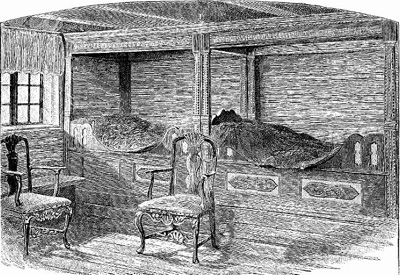
In the largest families, these beds could be stacked one on top of another — bunk-bed style — from floor to ceiling. Later examples were often made with beautiful, intricate woodwork, ornately carved and painted to match the surrounding wainscoting and other pieces of furniture.
In 17th and 18th century Holland, many working class homes had cupboard beds built permanently into the wall. Dutch settlers also brought this tradition to America, though, sadly, there are no surviving examples. They were also used extensively in western France — especially Brittany — where they were called lit clos (meaning closed bed). Box-beds and cupboard beds sometimes had curtains or wooden doors that could be drawn or pulled shut for warmth, privacy, and to keep out drafts.
Moving into Modern Times
Two important advances in the 1700’s were iron bed frames and cotton-filled mattresses with tufted covers. They both helped reduce the spread of disease by providing a less hospitable environment for microorganisms and insects which liked to nest in wood frames and traditional ticking. (When people said, “don’t let the bedbugs bite,” they meant it literally.) These beds were also more space-efficient — a must in the smaller rooms in most homes. Wood-frame beds still remained popular, however, especially in areas farther away from cities and towns.
The 1800’s brought the innovation of metal bedsprings which were attached to the inside of the frame for support. This offered additional sturdiness and a light bouncy give to the feel of the mattress. It also made that nameless, rusty, metallic squeak an ever-familiar sound in bedrooms everywhere. The springs were constructed out of heavy-guage metal wiring formed into a variety of shapes. In one method, the wire was woven in a lattice pattern to provide total head-to-foot and side-to-side support. In another construction, the wire was shaped in a continuous S-shape, or serpentine pattern. The most sophisticated method used short coils of two or three inches with hooks at each end — one end attached to the bed frame, the other to a metal slat or wire strung head-to-foot or side-to-side across the frame.
20th Century Beds
The 20th century gave us the innerspring mattress that we know today. The springs are integrated right into the mattress itself to provide support that’s considerably more even and less lumpy than an old-fashoned mattress. Although the patent was granted to Heinrich Westphal in the 1870’s, they weren’t manufactured until the 1920’s and even then didn’t gain much popularity until the post-war era.
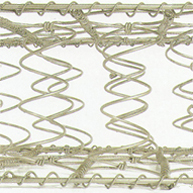
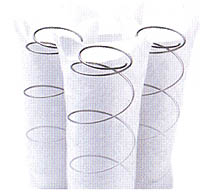
Innerspring mattresses are almost always used in combination with a box-spring platform underneath. Box-springs use heavy-duty springs housed inside a wooden frame, enclosed in a tidy cloth covering, to form a nice stable base for the mattress. They offer even better support and help prolong the life of the mattress by absorbing most of the weight.
The prosperous 1950’s brought us advanced, space-age materials such as foam. Foam rubber was used first — made with natural latex from the sap of the rubber tree mixed with gas bubbles — and soon replaced by polyurethane foam. This also produced the firm cushioning material used in chairs, sofas, and seats in automobiles. Foam mattresses as well as pillows were marketed as the product of the future, but were slow to catch on.
The waterbed first appeared on the market in the 1960’s but it didn’t really burst onto the scene until the 70’s, when it became the preferred bedding of the groovy, younger generation. Its high coolness factor may have stemmed from the notion that it would enhance the sexual experience. Waterbeds were considered far out and later awesome, but alas, by the early 90’s they had all but disappeared, along with cassette tapes and the mullet.
In 1992, memory foam mattresses were introduced in the United States by Tempur-Pedic, Inc. The viscoelastic foam is marketed as providing consistent support over the whole surface of the mattress, conforming to each sleeper’s body and needs, and allowing partners to move around in bed without disturbing each other. This is the amazing mattress, as seen on TV, which enables you — should the urge ever take hold — to jump up and down on the bed while your glass of red wine remains unspilled.
Beds in the 21st Century
Your choice of beds today is a vast array of styles, sizes, materials, features, benefits, and price ranges. You can choose the most up-to-date designs and materials, or buy an authentic antique bed from hundreds of years ago. You can sleep on water, air, foam, or a traditional mattress. Looking back on the changes and innovations over human history — especially during the last hundred years — who knows what we’ll be sleeping on in the future. Keep your eyes open.
